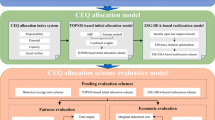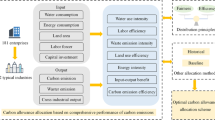Abstract
The carbon emission of China’s industry accounts for more than 70 % of the total in the nation, thus the implementation of carbon emission quota trading in industry is of great importance to realize China’s national carbon emission reduction targets. Meanwhile, the allocation of carbon emission quota among sectors or enterprises proves the first and critical step. For this reason, this paper constructs a comprehensive index combined with the subjective, objective and linear combination weighting methods to allocate carbon emission quotas among the 39 sectors of China’s industry in 2020 based on the level of 2015, and employs the input-oriented ZSG-DEA model to examine the efficiency of allocation solutions in 2020. The results indicate that, first, when carbon emission reduction capacity, responsibility and potential are considered for the comprehensive index of carbon emission quota allocation, the mitigation responsibility plays a relatively higher role than other two indicators. Second, all of the subjective, objective and linear combination weighting methods can be used for effective allocation of carbon emission quotas, and the former two methods have less advantage in light of efficiency. Third, six key industrial sectors are respectively allocated over 500 million tonnes of carbon emission quotas in 2020, which together account for 91.77 % of the total in the industry. Finally, the final carbon emission quota allocation solution reflects both the equity and efficiency principles and achieve the Pareto optimal state.
Similar content being viewed by others
Notes
References
Ahn, J. (2014). Assessment of initial emission quotas allocation methods in the Korean electricity market. Energy Policy, 43, 244–255.
Arrow, K., Bolin, B., Costanza, R., Dasgupta, P., Folke, C., Holling, C. S., et al. (1995). Economic growth, carrying capacity, and the environment. Ecological Economics, 15, 91–95.
Baer, P., Athanasiou, T., Kartha, S., & Kemp-Benedict, E. (2008). The greenhouse development rights framework: The right to develop in a climate constrained world (2nd ed.). Berlin: Heinrich Böll Foundation, Christian Aid, EcoEquity and the Stockholm Environment Institute. http://www.ecoequity.org/docs/TheGDRsFramework.pdf.
Beckerman, W., & Pasek, J. (1995). The equitable international allocation of tradable carbon emission quotas. Global Environmental Change, 5(5), 405–413.
Chang, C. C., & Lai, C. T. (2013). Carbon quotas allocation in the transportation industry. Energy Policy, 63, 1091–1097.
Charnes, A., Cooper, W. W., & Rhodes, E. (1978). Measuring the efficiency of decision making unites. European Journal of Operational Research, 2(6), 429–444.
Cheng, B. B., Dai, H. C., Wang, P., Zhao, D. Q., & Masui, T. (2015). Impacts of carbon trading scheme on air pollutant emissions in Guangdong Province of China. Energy for Sustainable Development, 27, 174–185.
Dragulescu, A., & Yakovenko, V. M. (2000). Statistical mechanics of money. The European Physical Journal B-Condensed Matter and Complex Systems, 17(4), 723–729.
Gomes, E. G., & Lins, M. P. E. (2008). Modelling undesirable outputs with zero sum gains data envelopment analysis models. Journal of Operational Research Society, 59(5), 616–623.
Gupta, S. M., & Bhandari, P. (1999). An effective allocation criterion for CO\(_{2}\) emissions. Energy Policy, 27(12), 727–736.
IPCC. (2006). 2006 IPCC guidelines for national greenhouse gas inventories. In: H. S. Eggleston, L. Buendia, K. Miwa, T. Ngara & K. Tanabe (Eds.), National greenhouse gas inventories programme. IGES, Japan. https://www.ipcc.ch/pdf/activity/2006gls-brochure.pdf.
IPCC. (2013). Climate change 2013: The physical science basis. Geneva, Switzerland. https://www.ipcc.ch/report/ar5/wg1/.
Jiang, Y. X., Chi, G. T., & Yan, L. J. (2011). The linear combination weights method based on maximum entropy principle. Operations Research and Management Science, 20(1), 53–59 (in Chinese).
Jiang, J. J., Ye, B., & Ma, X. M. (2014). The construction of Shenzhen’s carbon emission trading scheme. Energy Policy, 75, 17–21.
Lee, C. F., Lin, S. J., & Lewis, C. (2008). Analysis of the impact of combing carbon taxation and emission trading on different industry sectors. Energy Policy, 36, 722–729.
Liao, Z. L., Zhu, X. L., & Shi, J. R. (2015). Case study on initial allocation of Shanghai carbon emission trading based on Shapley value. Journal of Cleaner Production, 103, 338–344.
Lin, T., & Ning, J. F. (2011). Study on allocation efficiency of carbon emission permit in EU ETS based on ZSG-DEA model. The Journal of Quantitative & Technical Economics, 3, 36–50.
Lins, M. P. E., Gomes, E. G., de Mello, J. C. C. B. S., & de Mello, A. J. R. (2003). Olympic ranking based on a zero-sum gains DEA model. European Journal of Operational Research, 148, 312–322.
Lozano, S., & Gutierrez, E. (2008). Non-parametric frontier approach to modelling the relationships among population, GDP, energy consumption and CO\(_{2}\) emissions. Ecological Economics, 66(4), 687–699.
Miao, Z., Geng, Y., & Sheng, J. (2016). Efficient allocation of CO\(_{2}\) emissions in China: A zero sum gains data envelopment model. Journal of Cleaner Production, 112(5), 4144–4150.
Pan, X. Z., Teng, F., & Wang, G. H. (2014). Sharing emission space at equitable basis: Allocation scheme based on the equal cumulative emission per capital principle. Applied Energy, 113, 1810–1818.
Park, J. W., Kim, C. U., & Iscard, W. (2012). Permit allocation in emission trading using the Boltzmann distribution. Physica A, 391(20), 4883–4890.
Ringius, L., Torvanger, A., & Holtsmark, B. (1998). Can multi-criteria rules fairly distribute climate burdens? OECD results from three burden sharing rules. Energy Policy, 26(10), 777–793.
Serrao, A. (2010). Reallocating agricultural greenhouse gas emission in EU 15 countries. In Poster prepared for presentation at the Agriculture & Applied Economics Association (AAEA), CASE, & WAEA joint annual meeting, Denver, Colorado, USA, July 25–27.
Shannon, C. E. (1948). A mathematical theory of communication. Bell System Technical Journal, 27(3), 379–423.
Vadas, T. M., Fahey, T. J., Sherman, R. E., Demers, J. D., Grossman, Maul, Melvin, A. M., et al. (2007). Approaches for analyzing local carbon mitigation strategies: Tompkins County, New York, USA. International Journal of Greenhouse Gas Control, 1(3), 360–373.
Wang, Z. Y., Gu, H. F., Yi, X. X., & Zhang, S. R. (2003). A method of determining the linear combination weights based on entropy. Systems Engineering Theory and Practice, 3, 112–116 (in Chinese).
Wang, T. C., & Lee, H. D. (2009). Developing a fuzzy TOPSIS approsch base on subjective weights and objective weights. Expert Systems with Applications, 36, 8980–8985.
Wang, K., Wei, Y. M., & Zhang, X. (2012). A comparative analysis of China’s regional energy and emission performance: Which is a better way to deal with undesirable outputs? Energy Policy, 46, 574–584.
Wang, K., Wei, Y. M., & Zhang, X. (2013a). Energy and emissions efficiency patterns of Chinese regions: A multi-directional efficiency analysis. Applied Energy, 104, 105–116.
Wang, K., Zhang, X., Wei, Y. M., & Yu, S. W. (2013b). Regional allocation of CO\(_{2}\) emissions quotas over provinces in China by 2020. Energy Policy, 54, 214–229.
Winkler, H., Brouns, B., & Kartha, S. (2006). Future mitigation commitments: Differentiating among non-Annex I countries. Climate Policy, 5(5), 469–486.
Wu, F., Fan, L. W., Zhou, P., & Zhou, D. Q. (2012). Industrial energy efficiency with \(\text{ CO }_{2}\) emissions in China: A nonparametric analysis. Energy Policy, 49, 164–172.
Wu, L. B., Qian, H. Q., & Li, J. (2014). Advancing the experiment to reality: Perspectives on Shanghai pilot carbon emissions trading scheme. Energy Policy, 75, 22–30.
Xiong, L., Shen, B., Qi, S. Z., & Price, L. (2015). Assessment of allowance mechanism in China’s trading pilots. Energy Procedia, 75, 2510–2515.
Yu, S., Weikard, H. P., Zhu, X., & van Ierland, E. C. (2016). International carbon trade with constrained allowance choices: Results from the STACO model. Annals of Operations Research. doi:10.1007/s10479-016-2126-3.
Zhang, Y. J., & Hao, J. F. (2015). The allocation of carbon emission intensity reduction target by 2020 among provinces in China. Natural Hazards, 79(2), 921–937.
Zhang, Y. J., Wang, A. D., & Da, Y. B. (2014). Regional allocation of carbon quotas in China: Evidence from the Shapley value method. Energy Policy, 74, 454–464.
Zhang, Y. J., Wang, A. D., & Tan, W. P. (2015). The impact of China’s carbon allowance allocation rules on the products prices and emission reduction behaviors of ETS-covered enterprises. Energy Policy, 86, 176–185.
Zheng, L. Q. (2012). Sharing the carbon emission reduction responsibility across Chinese provinces: A zero sum gains DEA model. Recourse Science, 34, 2087–2096.
Zhou, X., James, G., Liebman, A., Dong, Z. Y., & Ziser, C. (2010). Partial carbon quotas allocation of potential emission trading scheme in Australian electricity market. IEEE Transactions on Power Systems, 25, 543–553.
Acknowledgments
We gratefully acknowledge the financial support from the National Natural Science Foundation of China (Nos. 71273028, 71322103) and the National Special Support Program for High-Level Personnel from the central government of China. We also would like to thank three responsible anonymous reviewers for their constructive comments and thank Dr. Ke Wang for his great help for the ZSG-DEA model.
Author information
Authors and Affiliations
Corresponding author
Appendices
Appendix 1
See Table 4.
Appendix 2
Rights and permissions
About this article
Cite this article
Zhang, YJ., Hao, JF. Carbon emission quota allocation among China’s industrial sectors based on the equity and efficiency principles. Ann Oper Res 255, 117–140 (2017). https://doi.org/10.1007/s10479-016-2232-2
Published:
Issue Date:
DOI: https://doi.org/10.1007/s10479-016-2232-2




